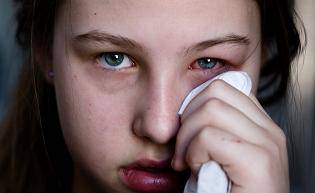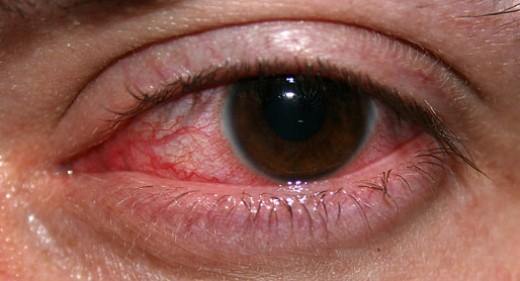
Dry eye is a condition in which there are insufficient tears to lubricate and nourish the eye. Tears are necessary for maintaining the health of the front surface of the eye and for providing clear vision. People with dry eyes either do not produce enough tears or have a poor quality of tears.
Problem of dry eye is a serious illness. Tears lubricant eye is needed as to remove all the dirt points to ensure better health. Tears are not just water, it is a liquid that contains water, fat, protein, electrolytes and bacteria disinfectant. The combination helps make clean, smooth surface of the eye.Without the tears we can not see clearly. Watery eye problems caused by dry eye problems. Dry eye problems often occur in women especially after menopause.

Dry Eyes Signs and Symptoms
Among the signs and symptoms of dry eyes are: –
1. Eyes felt painful and uncomfortable.
2. Feels there is a foreign body in the eye.
3. Watery eyes
4. Points to increased pain and discomfort when exposed to smoke or wind
5. Tired eyes while reading the short term.
6. Eyes sensitive to light
7. It is difficult to wear contact lenses.
8. Eyes became blurred and worsened during the night.
Dry Eyes Causes
In addition to an imbalance in the tear-flow system of the eye, dry eyes can be caused by situations that dry out the tear film. This can be due to dry air from air conditioning, heat, or other environmental conditions. Other conditions that may cause dry eyes are:
- The natural aging process, especially menopause
- Side effects of certain drugs such as antihistamines and birth control pills
- Diseases that affect the ability to make tears, such as Sjogren’s syndrome, rheumatoid arthritis, and collagen vascular diseases
- Structural problems with the eyelids that don’t allow them to close properly
Dry Eye Treatment
Dry eye can be solved with artificial tears, which is a liquid that is processed similar to real tears. Artificial tears can be placed into the eye without side effects. It can also be regarded as an eye lotion.
Dry eyes diagnoses
Dry eyes can be diagnosed by this method :-
Patient history to determine any symptoms the patient is experiencing and the presence of any general health problems, medications taken, or environmental factors that may be contributing to the dry eye problem.
External examination of the eye, including lid structure and blink dynamics.
Evaluation of the eyelids and cornea using bright light and magnification.
Measurement of the quantity and quality of tears for any abnormalities. Special dyes may be instilled in the eyes to better observe tear flow and to highlight any changes to the outer surface of the eye caused by insufficient tears
Dry eyes treatment
Dry eyes could be treat by doing this
Adding tears – Mild cases of dry eyes can often be managed using over-the-counter artificial tear solutions. These can be used as often as needed to supplement natural tear production. Preservative-free artificial tear solutions are recommended because they contain fewer additives that could further irritate the eyes. However, some people may have persistent dry eyes that don’t respond to artificial tears alone. Additional steps need to be taken to treat their dry eyes.
Conserving tears – An additional approach to reducing the symptoms of dry eyes is to keep natural tears in the eyes longer. This can be done by blocking the tear ducts through which the tears normally drain. The tear ducts can be blocked with tiny silicone or gel-like plugs that can be removed, if needed. A surgical procedure to permanently close tear ducts can also be used. In either case, the goal is to keep the available tears in the eye longer to reduce problems related to dry eyes.
Increasing tear production – Prescription eye drops that help to increase production of tears can be recommended by your optometrist, as well as omega-3 fatty acid nutritional supplements.
Treatment of the contributing eyelid or ocular surface inflammation – Prescription eye drops or ointments, warm compresses and lid massage, or eyelid cleaners may be recommended to help decrease inflammation around the surface of the eyes.
Reference : WebMD

Just for info. After eight months of great suffering I’ve experienced very significant relief from computer-related eye strain and dry eyes by using – guess what! honey!
Please check out details at: http://sabhlokcity.com/2011/05/announcing-a-candidate-solution-to-eye-strain-and-dry-eye/ should you be interested.